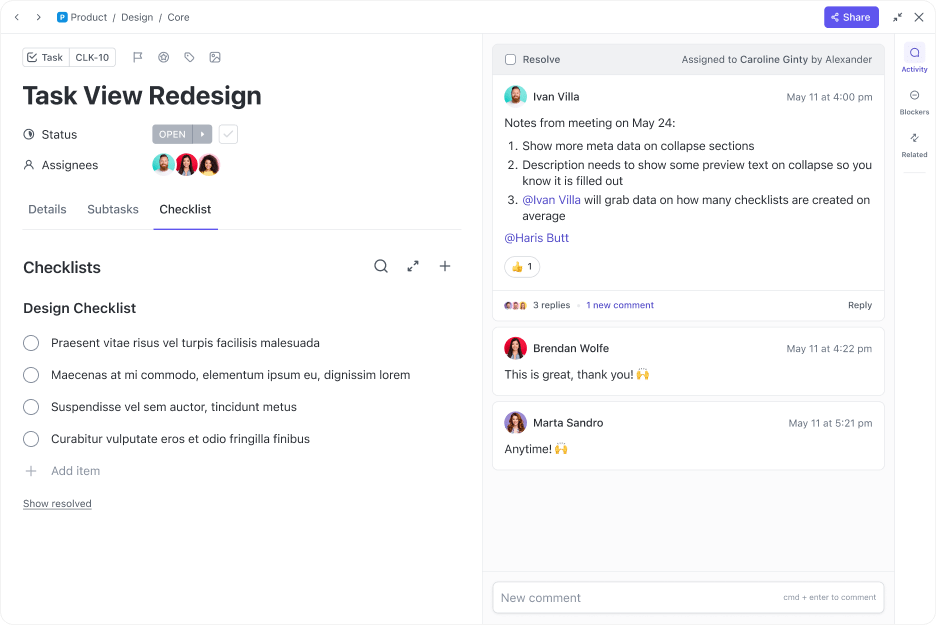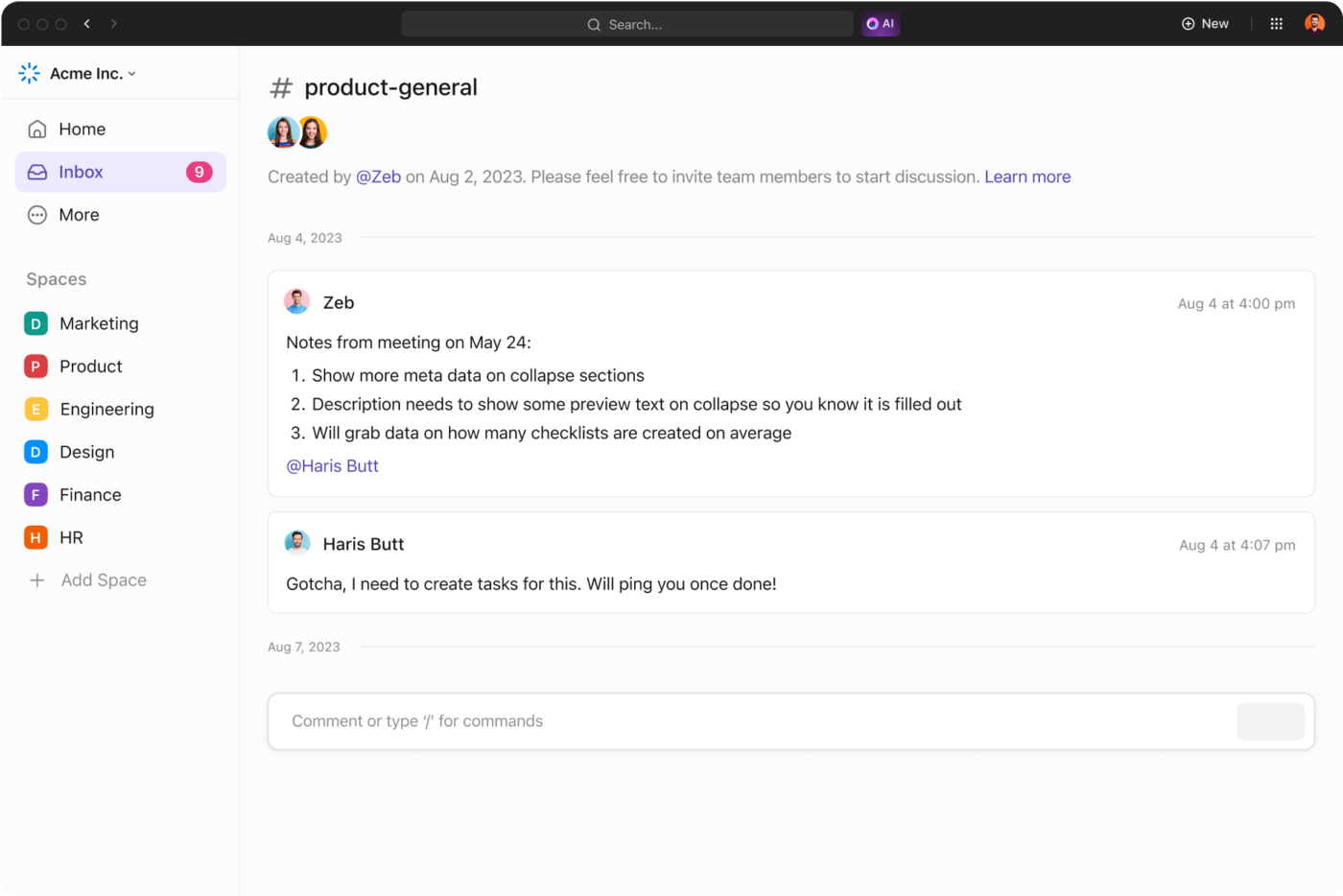

Construction management really dates back to ancient times, when civilizations like the Egyptians and the Chinese built the pyramids and the Great Wall. Then, the Industrial Revolution came along and introduced more structured ways to handle big projects.
As time passed, computers and other technological innovations changed the game in construction. But let’s be real: Whether dealing with materials or suppliers, keeping a construction project on track and within a budget is still a task.
Today, construction project management is marked by a software-driven approach to boosting efficiency. This major shift has significantly improved project planning, scheduling, and resource management, making construction management more precise and efficient.
Are you curious to learn more about this recent shift? Keep reading because we’ll be talking about effective construction project management tools and processes for your construction projects.
What is Construction Project Management?
Construction project management is the process of using specific tools and software to manage multiple project phases, including planning, organization, execution, and control of a construction project from conception to completion.
This allows construction companies to organize their activities more efficiently and helps them streamline multiple aspects of a construction project, including managing resources, budget, stakeholders, etc.
Construction projects are of many types, including:
- Residential construction: From single-family homes to sprawling apartment complexes, residential construction projects need effective management to ensure the timely and cost-effective delivery of living spaces
- Commercial construction: Think shopping malls, office buildings, retail spaces, hospitality projects, and more. The commercial construction industry requires project coordinators to navigate the complexities of these structures, ensuring they meet functional and aesthetic requirements despite a tight budget
- Industrial construction: Industrial projects involve power plants, factories, and warehouses. Here, construction project managers have to prioritize safety, efficiency, and adherence to stringent regulations
- Infrastructure construction: Roads, bridges, and public transportation systems are the lifeblood of our communities. Thus, the infrastructure construction industry needs trained managers to oversee the development and maintenance of these crucial structures
- Specialized construction: The construction industry also encompasses unique projects like marine construction (think offshore platforms) and historical restoration. Specialized construction project managers need expertise in not just construction project management but also these specialized industries
But more than a construction project manager or project owner, a successful construction project is all about team effort. So, a typical construction project management team often includes a variety of skilled professionals, each playing a crucial role in bringing the project to life, including:
- Project Manager: They oversee all aspects of the project, from planning and scheduling to budget management and communication
- Architects: They design the project’s layout, functionality, and aesthetics
- Engineers: They ensure the structural integrity, safety, and functionality of the build
- Surveyors: They map the land and provide precise measurements, which is crucial for accurate construction
- Contractors: They are responsible for the physical construction work, often leading a team of subcontractors specializing in various trades (electrical, plumbing, HVAC, etc.)
- Stakeholders: This group includes everyone with an interest in the project’s success, including the owner, investors, and end-users
The Construction Project Management Process
Whether building a large-scale bridge or a neighborhood library, the construction industry follows a similar process for project planning and execution. This process starts with the planning phase and ends with project closure or handover. The four key processes of construction project management are:
1. Ideation
In this phase, stakeholders meticulously assess every detail of the proposed project to ensure it aligns with the company’s current and future portfolio. Key considerations include
- Return on investment (ROI): A thorough financial analysis is conducted to assess the project’s profitability potential
- Regulatory compliance: The project’s adherence to all applicable building codes, zoning regulations, and environmental standards is crucial since non-compliance can result in costly delays and rework
- Integration with existing projects: Ensuring smooth integration minimizes disruptions and optimizes resource allocation
- Risk assessment: Proactive risk identification allows for the development of contingency plans to mitigate potential losses
The main goal of ideation is to generate various high-value projects while controlling risks. A project that could bring in a lot of profit might not be the best choice if it comes with high risks. Even if included in the project lineup, it will need close monitoring and adjustments throughout its lifecycle.
2. Planning
Once a project receives the green light, it’s time to define and plan every aspect to prevent scope creep and ensure a smooth execution. This stage involves solidifying several crucial elements:
- Project scope: Clearly defining the project’s boundaries—what will be built and what won’t—is essential. A well-defined scope sets realistic expectations and minimizes the risk of uncontrolled project expansion
- Feasible timeline: Developing a realistic and achievable project schedule is paramount. Techniques like the Critical Path Method (CPM) can be used to identify the most critical tasks and their dependencies, ensuring the project stays on track
- Resource allocation: Correctly determining the human resources, equipment, and materials required to complete the project is crucial for efficient resource management. A comprehensive resource plan ensures everything is in place to avoid delays caused by unforeseen shortages
- Budgeting with accuracy: Creating a realistic and well-defined budget is essential to avoid overruns later. This budget should account for all anticipated costs, including materials, labor, equipment, permits, and potential contingencies
- Key performance indicators (KPIs): Establishing clear and measurable KPIs allows for effective project monitoring. These metrics could track progress against the schedule, budget adherence, and quality control effectiveness
3. Assigning
Construction projects involve many different people who all have specific jobs to do. It’s vital to clearly lay out these jobs right from the start for a few key reasons, including:
- Accountability: When everyone understands their specific responsibilities, it’s easier to hold individuals accountable for their actions and contributions to the project
- Clarity and streamlining: Clearly defined roles eliminate confusion and redundancies. So, if the team members know exactly what’s expected of them, tasks will not fall through the cracks due to miscommunication
- Efficiency and collaboration: When everyone understands their role and how it contributes to the bigger picture, collaboration and overall project efficiency are enhanced
4. Execution
Before construction begins, project managers should meet with key stakeholders for a final review to ensure everyone agrees on the construction plans, budget, and timeline. Even though challenges can come up during construction, getting everyone’s approval at the beginning helps prevent big problems later.
During construction, the project team and manager play a crucial role. They closely monitor and track every activity to ensure the project stays on schedule and follows the right procedures. They use real-time data and key performance indicators (KPIs) to keep things moving smoothly. These metrics could include:
- Schedule variance: Tracks how well the project adheres to the established timeline
- Budget variance: Monitors deviations from the allocated budget
- Quality control: Measures the project’s adherence to quality standards
- Safety performance: Tracks the project’s safety record and identifies any potential hazards
The Construction Project Management Lifecycle
Once a construction project hits the execution phase, it usually follows the five-step process of the construction project lifecycle, including:
Project initiation
It involves defining the project’s purpose, conducting feasibility studies, and setting SMART goals (Specific, Measurable, Achievable, Relevant, and Time-Bound). Moreover, the stakeholders are identified, and an initial budget is set.
This initiation stage aligns with the initial planning phase of the systems development life cycle (SDLC), where project requirements are gathered, feasibility is assessed, and a high-level plan is created.
Project planning
This stage involves creating a detailed project schedule, often using construction management terms like the Critical Path Method (CPM) to identify the most critical tasks that can’t be delayed without impacting the entire project timeline.
A comprehensive budget breakdown is also created, outlining costs for materials, labor, equipment, and potential contingencies that will impact project costs. Then, the permits are secured, and initial communication channels are established with key stakeholders.
The project planning phase in construction management closely resembles the design phase in the systems development lifecycle (SDLC). Both stages involve detailed planning, resource allocation, and the creation of a clear roadmap for project execution.
Also read: A guide to project cost management
Project launch
The construction team assembles, starts materials procurement, and begins site preparation. This stage is all about implementing the project plan and ensuring clear communication between all parties involved.
It also involves implementing quality measures to ensure the construction meets specified standards. For that, most projects use procurement management software or a comprehensive construction project management tool for efficiency.
The project launch stage aligns with the development phase in the SDLC. In both, the project transitions from planning to execution, focusing on assigning resources, task completion, and quality control.
Performance monitoring
Teams must monitor progress throughout the project lifecycle. This stage involves regularly tracking the project performance against the set schedule and budget to ensure quality standards are met. If required, necessary adjustments are made to address any deviations from the plan. These are also communicated with the stakeholders to keep everyone informed of progress and potential roadblocks.
This phase is similar to the testing and implementation phase in the SDLC. Both involve thorough testing, detecting and fixing mistakes, and ensuring the final product meets the desired specifications.
Project closing
This stage involves final inspections, handover to the client, and post-construction activities like warranty fulfillment. Further, the lessons learned are documented for future projects, and the team celebrates their success!
Project closing in construction management is like the maintenance phase in the SDLC, as it involves finalization, handover, and documenting insights gained to inform future endeavors.
Since every project management lifecycle follows a process similar to a software lifecycle, most construction ERP software follow these standards to define each stage in the construction project.
Tools to Manage Construction Projects
In the past, construction projects used manual methods and different tools for scheduling, communication, and document management. This often caused problems like information silos, communication issues, and challenges in keeping track of progress.
However, construction scheduling software has streamlined the entire construction process, enabling stakeholders and project managers to track project milestones easily.
Adopting comprehensive construction project management software allows construction companies and organizations to gain several advantages, including:
- Centralized communication: Use construction project management software to streamline communication between project stakeholders, including architects, engineers, contractors, and clients. Real-time updates, task discussions, and file sharing ensure everyone is on the same page
- Enhanced task management: Break down complex projects into manageable tasks, assign them to team members, and track progress visually. This fosters accountability and keeps projects moving forward efficiently
- Improved scheduling and resource allocation: Create detailed project schedules, identify task dependencies, and allocate resources effectively. Construction project management tools help visualize critical paths and potential bottlenecks, allowing for proactive adjustments
- Document management: Store project documents—from blueprints and contracts to safety protocols and site photos—in a central, easily accessible location
ClickUp, an end-to-end productivity management solution, also doubles as effective construction project management software. With ClickUp for Construction teams, you can simplify the overall construction management process, from planning to managing and tracking KPIs. By using this tool, you can:
Build your ideal workflow

ClickUp offers a robust feature set that caters specifically to the construction industry:
- Task checklists: Create detailed checklists for each construction phase using ClickUp Task Checklists, so you don’t miss a critical step
- Customizable fields: Tailor ClickUp to your specific needs by creating ClickUp Custom Fields for tracking materials, permits, resources, tasks, or labor costs
- Gantt charts: Visualize project timelines easily with the ClickUp Gantt Chart view. Track progress, identify dependencies, and make adjustments as needed.
- Mind maps: Brainstorm project ideas, break down complex tasks, and visually represent project workflows using ClickUp Mind Maps functionality
Collaborate from office to job site

Foster seamless communication between all project stakeholders, ensuring everyone is on the same page and working towards shared goals. With ClickUp’s collaboration features, you can:
- Brainstorm ideas: Use ClickUp Whiteboards, the world’s only virtual whiteboard that can turn your ideas into coordinated actions for your construction project. Add links, files, Docs, or more to your whiteboard ideas. Assign tasks and create actionable plans and end-to-end projects from a creative canvas
- Work with diverse teams on documents: Tag team members, add comments, and update documents in real-time using Clickup Docs. You can even assign action items for your activities, ensuring that you can always monitor and track each outstanding activity
- Communicate effectively: Streamline your entire organizational communication with Clickup Chat view. This allows all your stakeholders and teams to communicate and share ideas on a shared dashboard or in Tasks. Anyone can add comments, assign tasks within comments, and even tag using @mentions. With rich format editing and chat alongside particular projects or documents, you can gain clarity on the expectations and inculcate effective communication within your construction projects
Mitigate risks effectively
Construction projects are inherently susceptible to unforeseen challenges and need constant vigilance and restructuring. With ClickUp, you can monitor all your activities and understand project progress for effective project management by:
- Proactive risk identification: During the project execution phase, you can stay on top of all the activities and generate reports using ClickUp Views. With 15+ fully customizable views, you can monitor the entire project development cycle, taking proactive actions to mitigate any risks or challenges that can impact the overall project
- Improved workflows: Automate repetitive tasks, centralize document management, and optimize project workflows for increased efficiency using ClickUp Automations. This allows your teams to focus on core activities while operational and repetitive tasks are automatically executed, creating effective project delivery
Leverage the power of AI

With advanced AI-based construction management tools, you can take project automation to the next level. ClickUp Brain, the in-build AI assistant, helps you revolutionize your construction projects by:
- Automating administrative tasks: Stop wasting time on manual and repetitive work, as you can use AI Project Manager to create status reports automatically. Generate standups, provide summaries of recent actions, and even write detailed project reports
- Improving communication: Don’t let language impede your project communication. With AI Writer for Work, you can create content and even generate templated replies, helping you improve your overall team communication. Plus, you can use the built-in spell check and quick replies to tailor any message, making sure it is grammatically correct and clear for everyone to understand
- Instantly answering your questions: Have questions about a project or task? With AI Knowledge Manager, you can get all the answers from your tasks, docs, and people. This ensures that you can check in with the app for any questions and get the answers quickly, be it about wikis, products, reports, or other insights
Gain improved efficiency using templates
ClickUp gives you multiple ready-to-use templates tailored for the construction industry. Instead of planning and executing construction projects from scratch, use these customizable templates to streamline the construction lifecycle processes, including ideation, execution, pre-sales, and final delivery.
With pre-built views, Custom Fields, Custom Statuses, Docs, and more, the ClickUp Construction Management Template allows you to manage all aspects of your construction operations in one place
- Plan and visualize every aspect, from sales strategies to project lifecycles
- Manage team and contractor resources effectively to promote smooth cooperation and meet project goals
- Monitor goals and advancement closely to guarantee prompt and cost-effective delivery, closely monitor goals and advancement
With ClickUp by your side, you’ll have the tools and capabilities needed to transform your construction projects from blueprints to stunning realities.
Build Your Dream Project Using ClickUp
Construction project management today is streamlined and automated to a great extent. The many project management tools available help in effectively planning and executing construction processes. However, the construction industry still needs you to jump through multiple hoops and navigate its complexities with the right expertise.
With effective construction project management software, you can plan your projects meticulously, including clear communication and task assignments. This allows you to foresee challenges or risks and make the right decisions proactively to help meet these challenges head-on.
With tools like ClickUp, you can complete projects on time, within budget, and to the highest quality standards.
So, the next time you embark on a construction project, remember—you’re not alone. Equipped with the knowledge of construction project management and the power of ClickUp at your fingertips, you can transform your vision into a remarkable, enduring structure.
Sign up today and get the power to manage even the most complex construction projects with ease.




